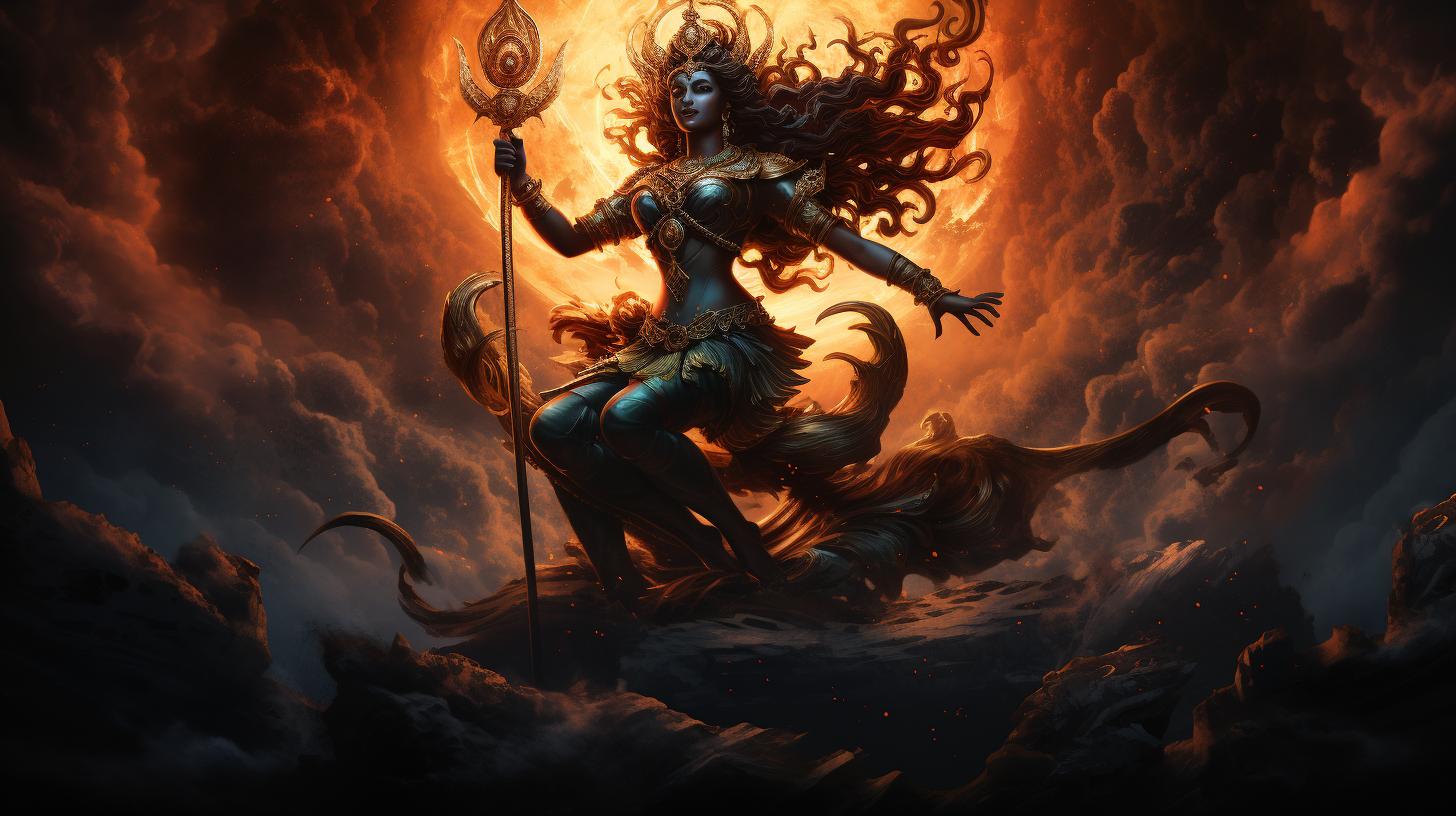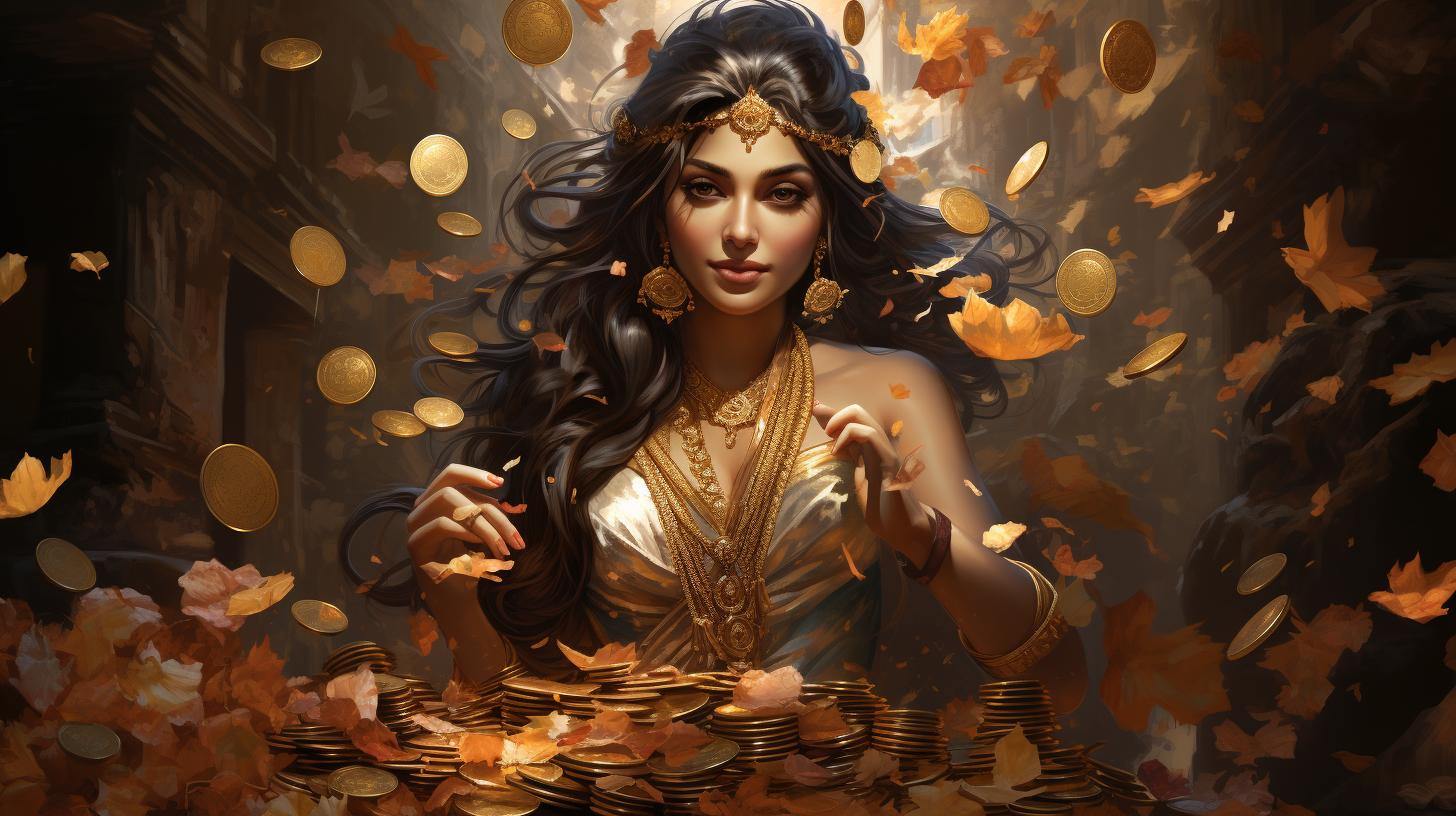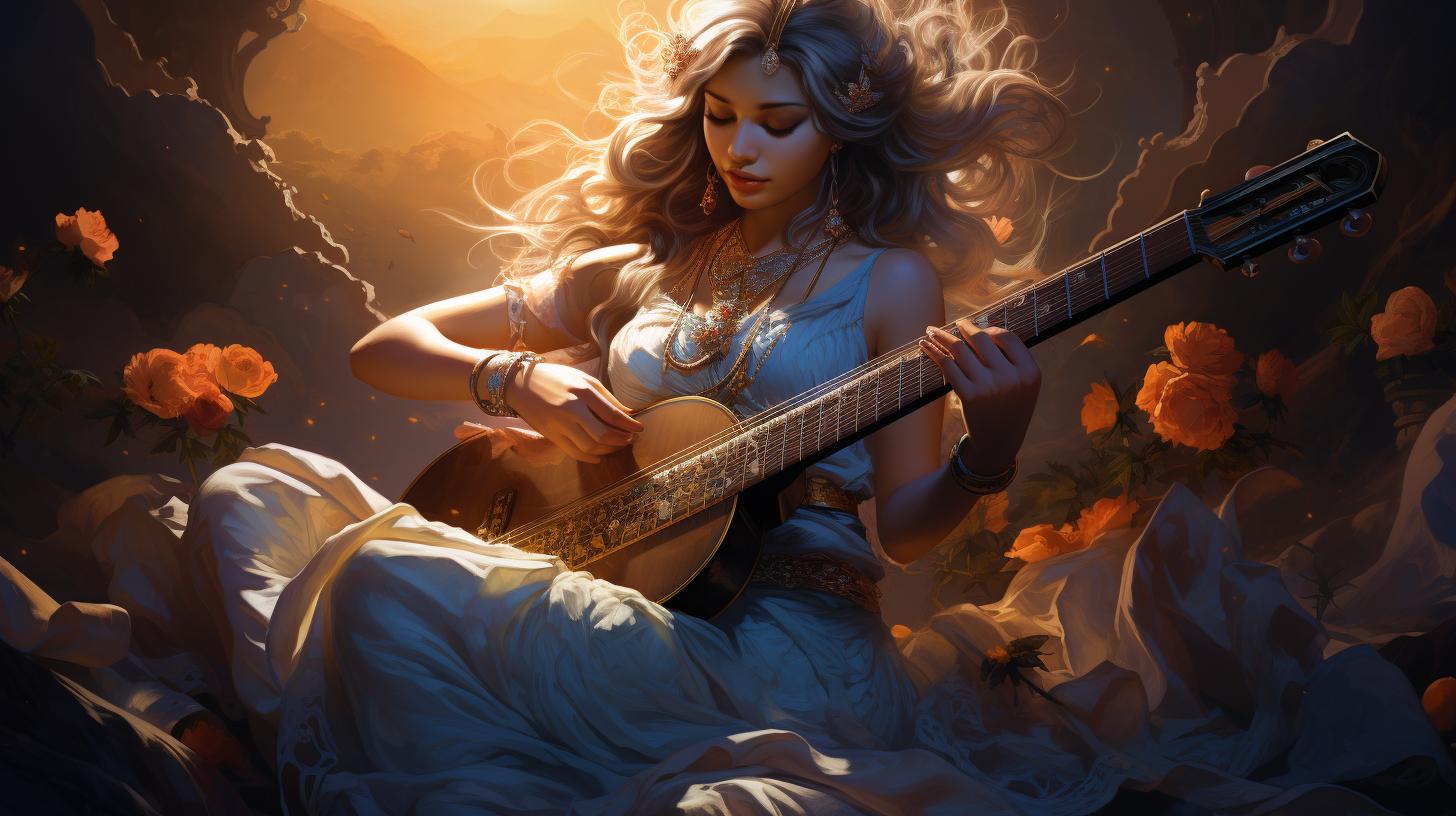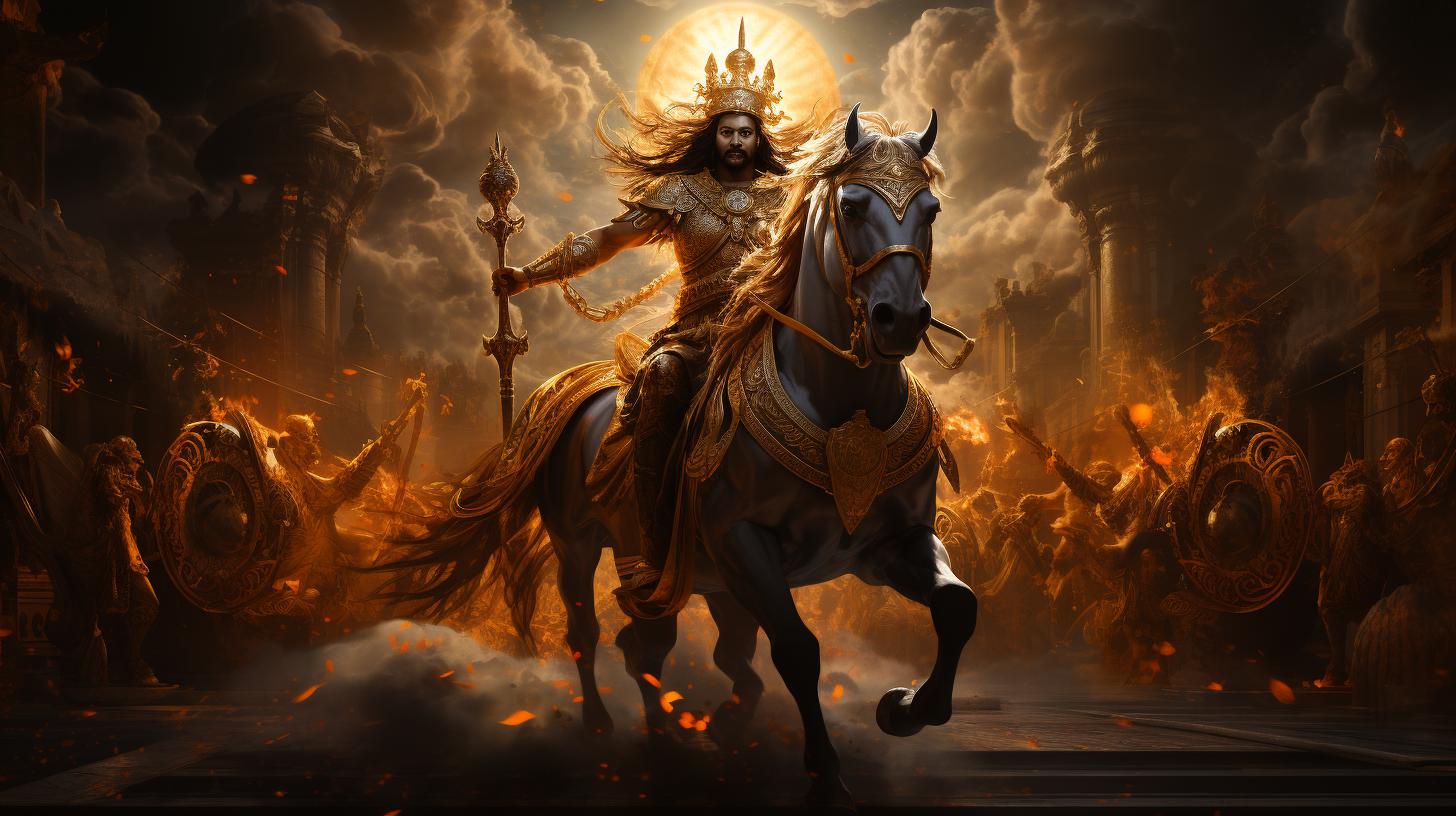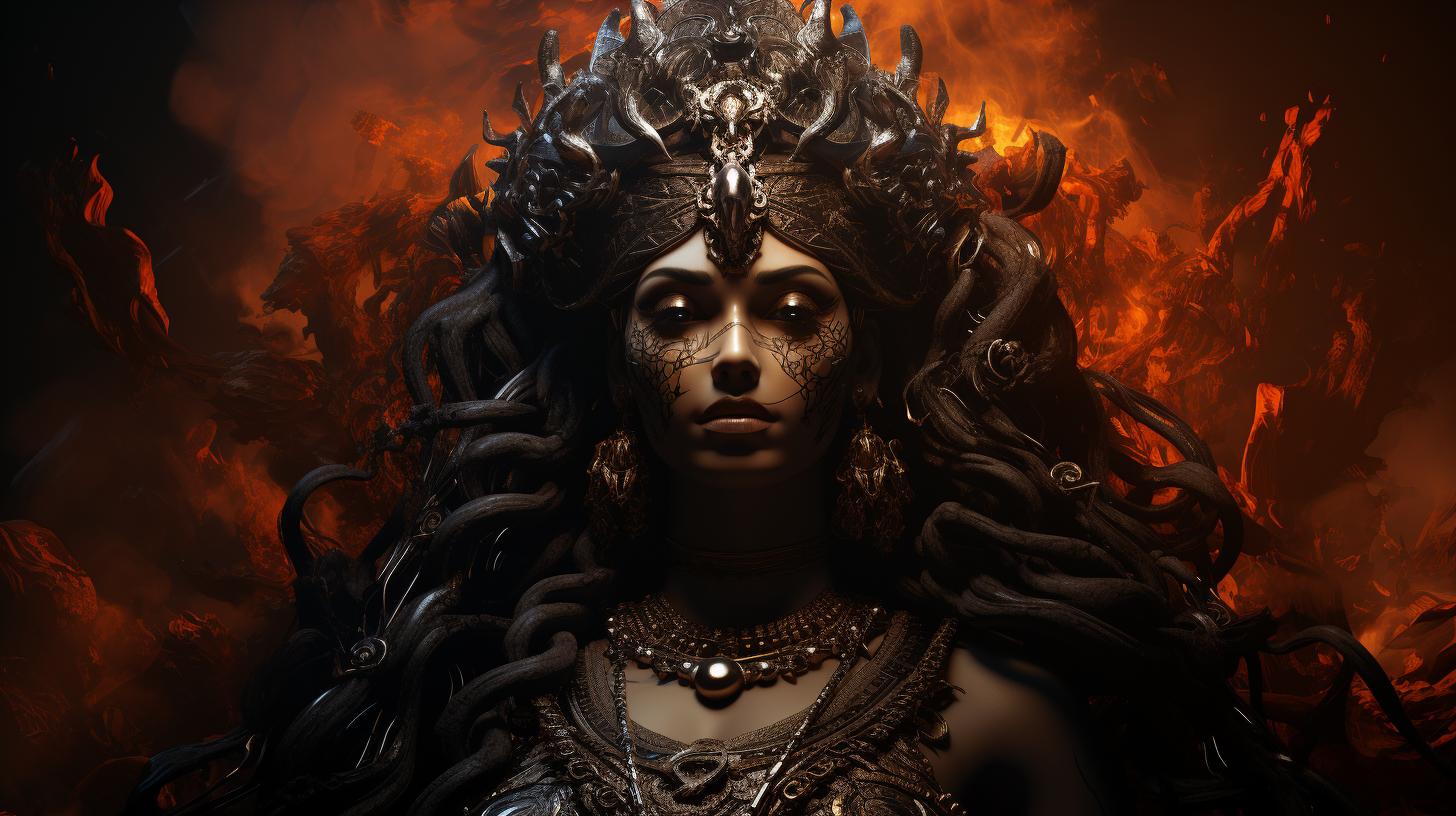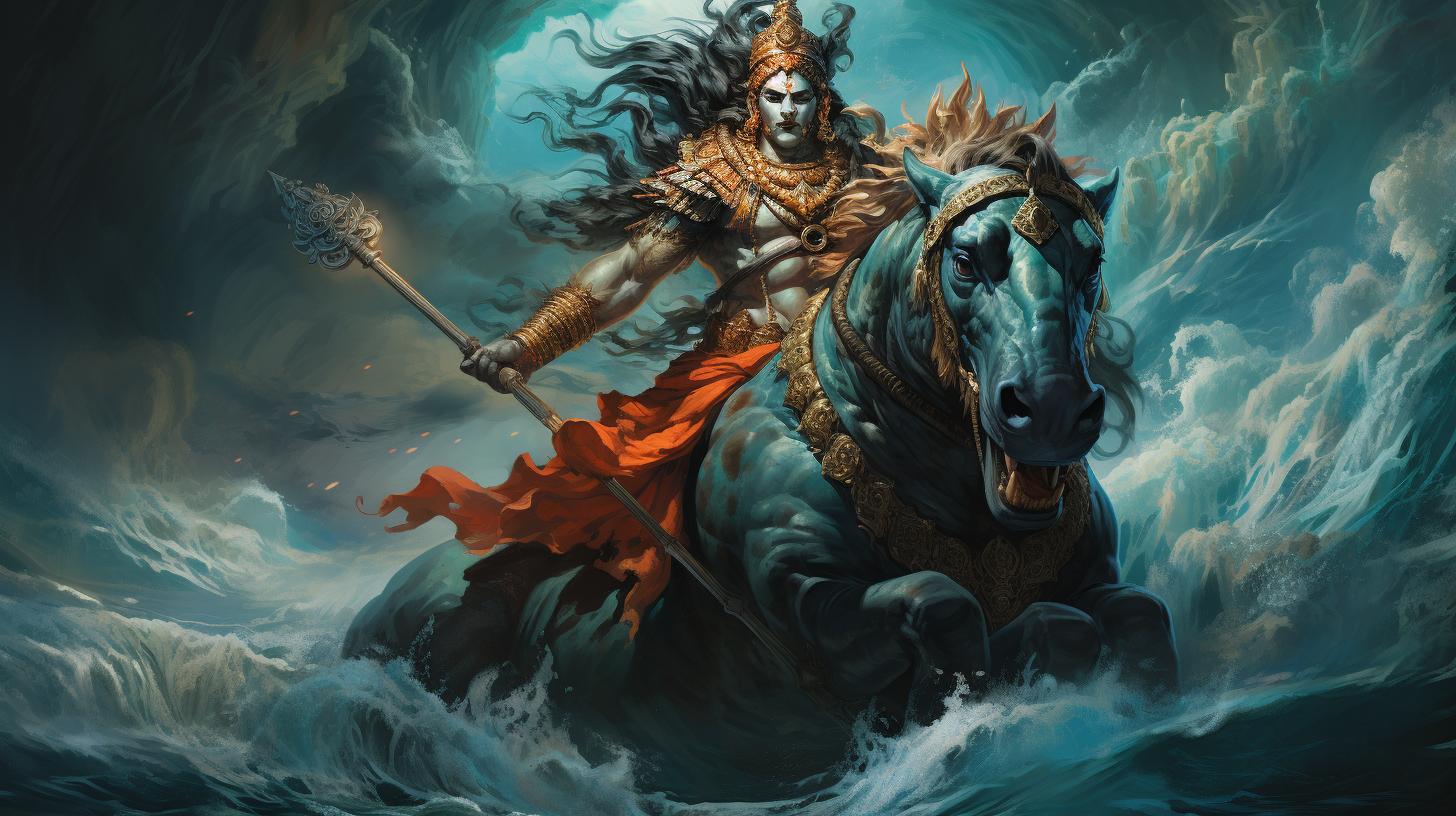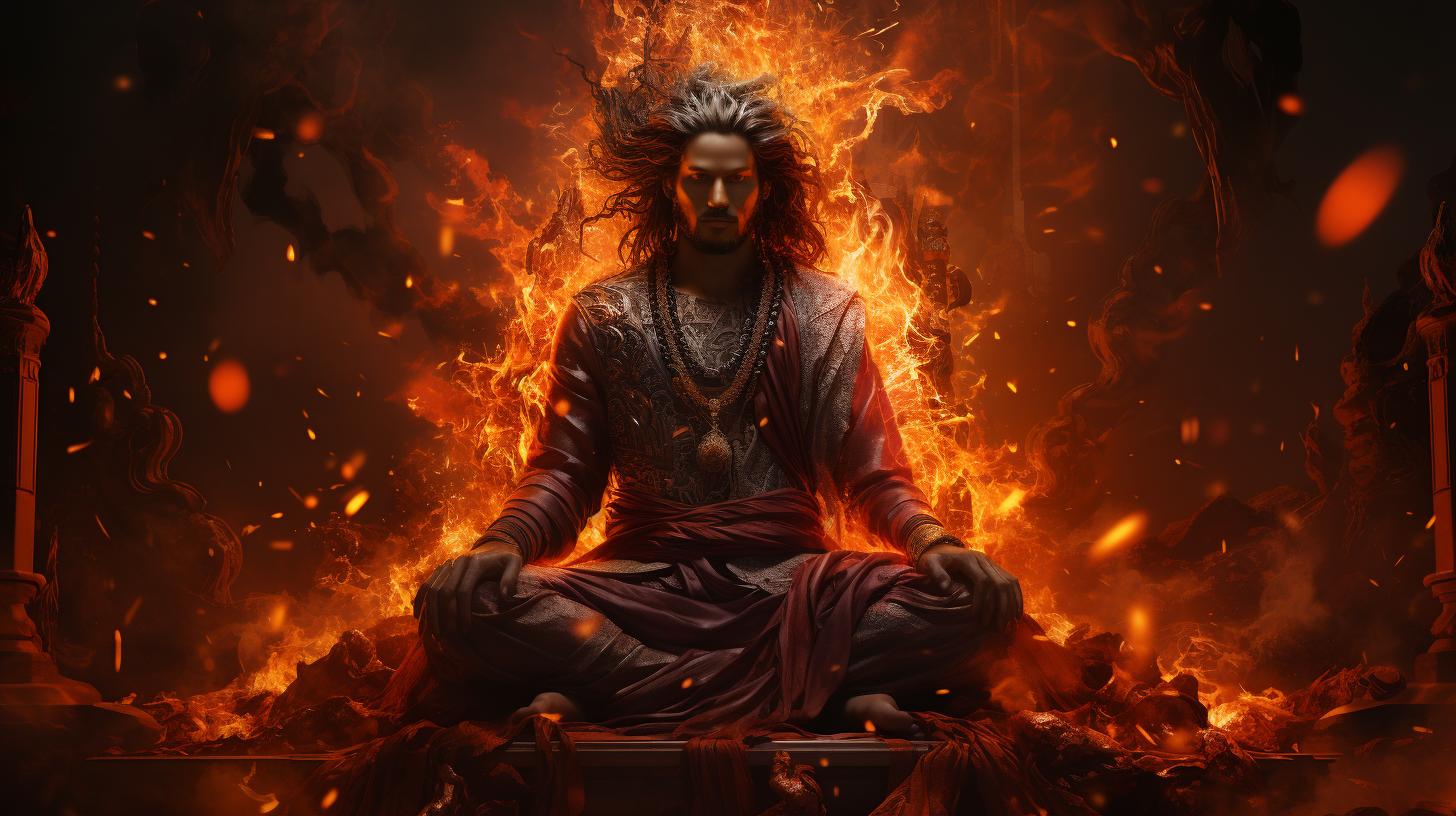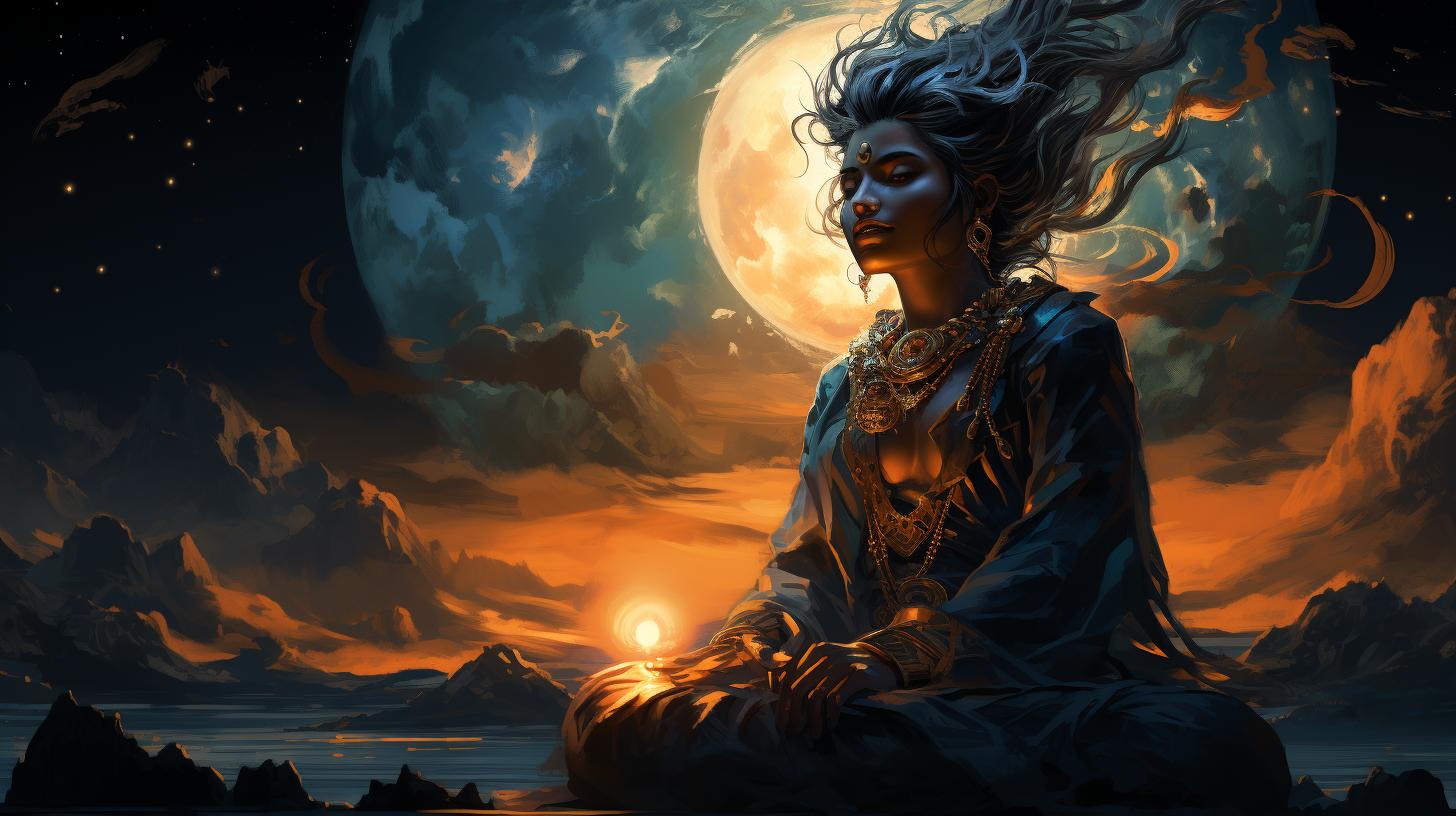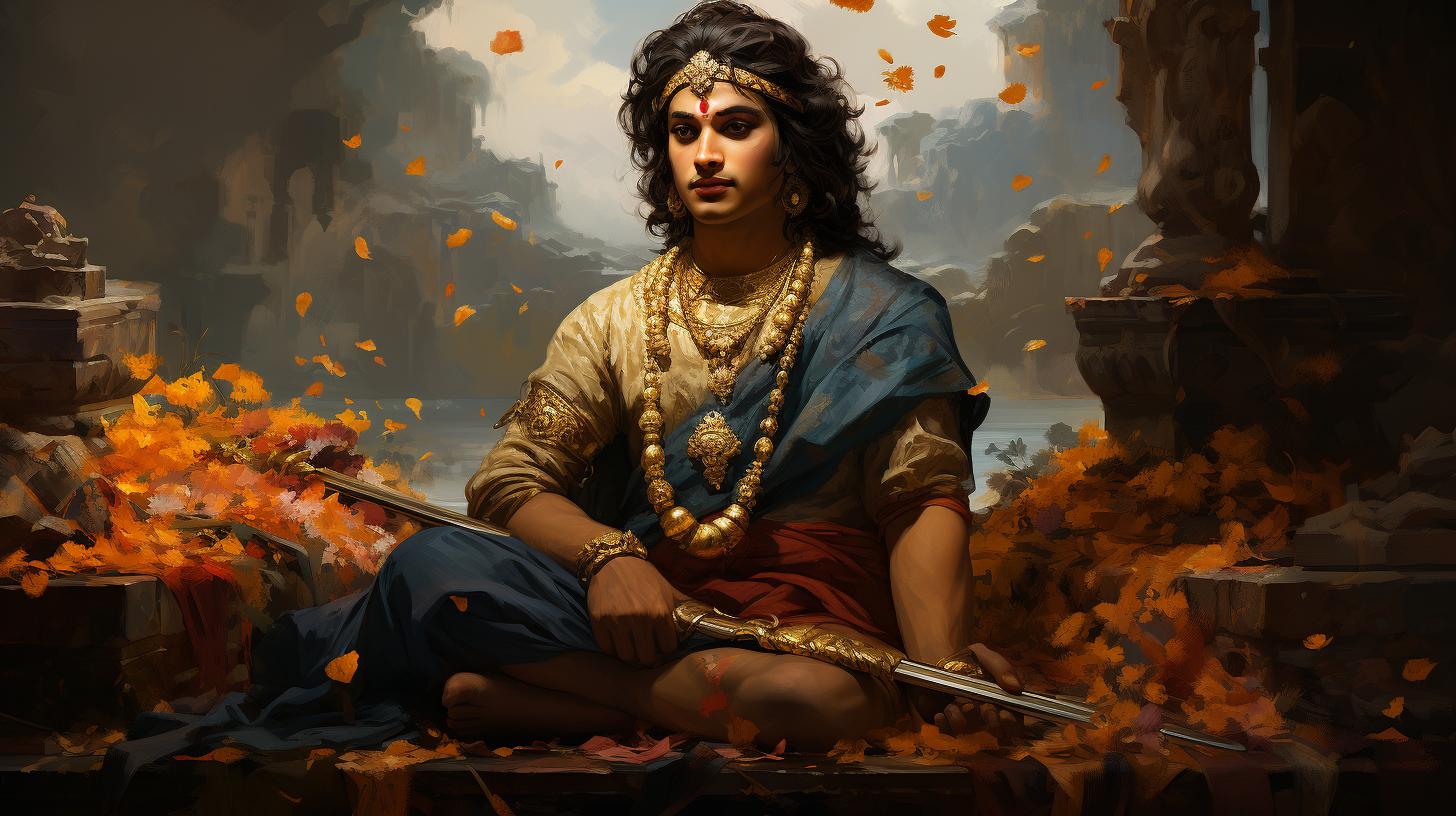Durga vs Kali: Unite the Fiercest Goddesses in a Mythical Battle
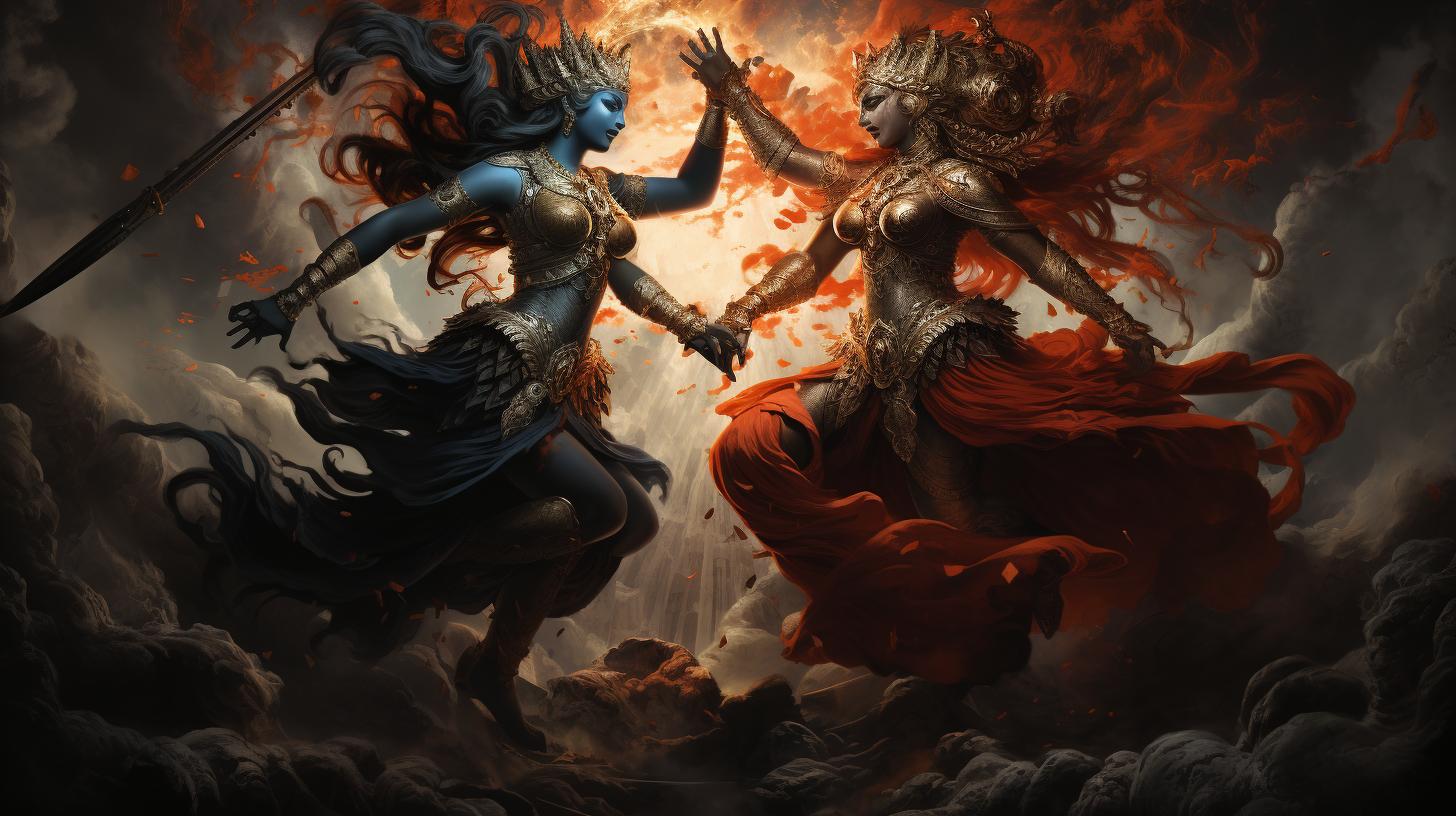
Durga and Kali, two powerful goddesses in Indian mythology, have captivated the minds and hearts of people throughout history. Their origins, characteristics, and cultural significance have been subjects of fascination and reverence.
From the grand festivities of Durga Puja to the intense devotion of Kali Puja, these goddesses inspire awe and reverence. Through art, literature, and popular culture, their iconic images have endured and influenced contemporary society.
Durga and Kali also serve as symbols of empowerment, challenging patriarchal norms and inspiring women’s rights movements. Let’s explore the intriguing world of these mythical goddesses, debunking misconceptions and appreciating their profound impact.
The Origins of Durga and Kali in Indian Mythology
The captivating goddesses, Durga and Kali, have their roots deeply interwoven in ancient Indian mythology. Each goddess has her own unique story, embodying different aspects of feminine power and strength.
The Story of Goddess Durga
Goddess Durga is revered as the divine mother, known for her ability to combat evil and restore balance in the world. According to legend, she was created by the gods to defeat the formidable demon, Mahishasura.
Equipped with weapons gifted by various deities, Durga engaged in a fierce battle with the demon, ultimately vanquishing him. Her triumph symbolizes the victory of good over evil.
The Story of Goddess Kali
Goddess Kali, on the other hand, embodies the ferocious and destructive aspect of feminine energy.
It is believed that Kali emerged from the forehead of Goddess Durga during a battle against the demon, Raktabija. With her terrifying appearance and a thirst for blood, Kali annihilated the demon and his army, bringing an end to their reign of terror.
She symbolizes the power to destroy negativity and ignorance.
These stories form the foundation of Durga and Kali’s mythological origins, portraying their roles as fierce protectors and bringers of justice in the Hindu pantheon.
Durga and Kali: The Two Powerful Goddesses
Durga and Kali are two awe-inspiring goddesses in Indian mythology, each with their own unique characteristics and attributes that make them formidable figures. Let’s delve into the individual traits of these powerful deities and explore the symbolism and meaning behind their forms.
- Durga, also known as Mahamaya, is depicted as a fierce warrior goddess.
- She possesses extraordinary strength, courage, and the ability to defeat evil forces.
- Her multiple arms symbolize her ability to multi-task and handle various aspects of life.
- Durga is often depicted riding a lion or tiger, representing her fearlessness.
- She is associated with protection, righteousness, and the preservation of moral order.
- Devotees worship Durga to seek her blessings for strength, prosperity, and victory over obstacles.
The Characteristics and Attributes of Goddess Kali
- Kali, the fierce and dark goddess, represents destructive forces that annihilate ignorance and ego.
- She is portrayed with a terrifying appearance, often depicted with a protruding tongue and a necklace of skulls.
- Kali’s unbound hair signifies her wild nature and freedom from societal norms.
- She is associated with time, death, and the transformative aspects of existence.
- Kali embodies destruction to pave the way for new beginnings and spiritual growth.
- Worshipers seek her blessings to conquer internal demons and attain liberation.
The Symbolism and Meaning Behind Their Forms
The contrasting forms of Durga and Kali convey deeper symbolism and meaning.
Durga’s form as a warrior goddess represents the power to overcome external challenges and protect righteousness. On the other hand, Kali’s fearsome appearance and destructive nature symbolize the need to confront and overcome inner demons and attachments for spiritual growth and transformation.
They both represent different aspects of the divine feminine, showcasing the diversity and complexity of the goddess energy in Hindu mythology.
Cultural Significance and Festivals
The cultural significance of Durga and Kali extends beyond their mythological origins, permeating various aspects of Indian society. Through vibrant festivals and religious observances, devotees express their reverence and celebration for these powerful goddesses.
Durga Puja: Celebrating the Goddess Durga
Durga Puja, one of the most widely celebrated festivals in India, pays homage to the divine feminine energy embodied by Goddess Durga. This grand event takes place over a period of ten days, with elaborate rituals, artistic decorations, and vibrant processions.
Devotees offer prayers and seek blessings from Durga, who is invoked to destroy evil forces and restore peace and prosperity. The festival culminates with the immersion of Durga’s idols in rivers, symbolizing the deity’s return to her cosmic abode.
Kali Puja: Honoring the Fierce Goddess Kali
Kali Puja, also known as Shyama Puja, is a significant festival dedicated to the fierce and formidable Goddess Kali. Celebrated predominantly in the eastern part of India, particularly in Bengal, this festival showcases the devotion and adoration for Kali. Devotees perform rituals, light lamps, and offer sacrifices to honor the goddess, seeking her blessings for power, protection, and liberation.
The mesmerizing ambiance, replete with incense, flowers, and chants, creates a mystical experience for the worshippers.
Other Festivals Dedicated to Durga and Kali
Apart from Durga Puja and Kali Puja, there are numerous regional festivals that celebrate the divine presence of both goddesses. Navaratri, a nine-night festival, encompasses the worship of Durga in various forms.
These festivals amplify the cultural significance of Durga and Kali, fostering a sense of unity and devotion among communities across India.
In conclusion, the cultural significance of Durga and Kali is deeply rooted in Indian society, as expressed through various festive celebrations.
Durga Puja and Kali Puja stand as prominent examples, where devotees come together to honor and seek the blessings of these powerful goddesses.
These festivals serve as reminders of the eternal cosmic energy represented by Durga and Kali, inspiring awe, devotion, and a profound appreciation for the divine feminine in Indian culture.
Depictions in Art, Literature, and Popular Culture
The rich and diverse representations of Durga and Kali in Indian art, literature, and popular culture showcase their enduring influence and significance. From ancient sculptures to contemporary paintings, artists have captured their powerful forms, symbolizing protection, strength, and fierce determination.
The Representation of Durga and Kali in Indian Art
The artistic depiction of Durga and Kali in Indian art has been a subject of fascination for centuries. In sculptures and paintings, Durga is often portrayed with multiple arms, holding weapons, and riding a lion or tiger, showcasing her warrior nature.
Kali, on the other hand, is typically depicted with a fierce demeanor, wearing a necklace of skulls and holding a severed head, symbolizing her ferocity and detachment from worldly attachments.
Artists use vibrant colors and intricate details in their portrayal of these goddesses, capturing their essence and evoking a sense of awe. The images not only depict their divine forms but also convey their strength, bravery, and ability to conquer evil.
Durga and Kali in Indian Literature and Mythology
Durga and Kali feature prominently in Indian literature and mythology, with their stories captivating readers across generations. In ancient texts like the Devi Mahatmya and the Markandeya Purana, the tales of Durga’s battles against demons, such as Mahishasura, highlight her role as a protector of righteousness and destroyer of evil.
Kali, on the other hand, is associated with primal and raw power, often depicted in mythological stories as the force that emerges from Durga during her epic battles. Her mythology explores the balance between creation and destruction and the transformative power of time.
The Influence of Durga and Kali in Popular Culture
Durga and Kali continue to captivate popular culture and are embraced in various forms of media. Their images and symbolism have found their way into films, television shows, and music videos, becoming synonymous with strength, empowerment, and feminine energy.
In literature, modern authors draw inspiration from Durga and Kali, creating compelling narratives that delve into their mythical stories and explore their relevance in contemporary society. These depictions not only entertain but also educate, spreading awareness about the divine feminine and the enduring power of these goddesses.
Furthermore, their symbolism has been used in various social and political contexts, engaging with issues of gender equality, empowering women, and challenging patriarchal norms. Durga and Kali stand as powerful icons, symbolizing resistance, courage, and the capacity to challenge oppressive systems.
- Various art forms, such as dance, theater, and poetry, also draw inspiration from Durga and Kali, exploring their multifaceted nature and celebrating their significance in Indian culture.
- Contemporary fashion, jewelry, and merchandise often incorporate images and symbols associated with Durga and Kali, representing empowerment, protection, and fierce independence.
- Their presence in pop culture extends beyond India, as their universal appeal resonates with people worldwide, inspiring a sense of awe and admiration.
The influence of Durga and Kali in art, literature, and popular culture continues to evolve, reflecting the timeless allure and enduring power of these captivating goddesses.
Empowerment and Resistance: Durga and Kali as Icons
Empowerment and resistance movements have found inspiration in the formidable goddesses, Durga and Kali. Their portrayal in feminist and empowerment movements showcases their strength and serves as a source of empowerment for women and marginalized communities.
Durga and Kali in Feminist and Empowerment Movements
Durga, with her fierce determination and courage, has become an emblem for female empowerment. Women’s rights activists and feminists see in her the embodiment of resilience and a symbol of feminine strength.
Durga’s victory over the buffalo demon Mahishasura represents the triumph of good over evil and serves as a powerful metaphor for the struggles faced by women.
Kali, on the other hand, embodies raw power and the destruction of oppression.
She symbolizes the liberation of suppressed voices and the overthrow of societal norms that perpetuate gender inequality. Kali’s unapologetic fierceness resonates with those challenging patriarchal structures and redefining feminine power.
Challenging Patriarchy: Durga and Kali as Symbols
Durga and Kali’s images have been used to challenge patriarchal norms and advocate for women’s rights. Artists, writers, and activists often depict Durga and Kali as symbols of resistance against oppression.
Their portrayal serves as a reminder that women can reclaim their power and challenge the dominance of male-dominated societies.
Through their stories and symbols, Durga and Kali inspire women to challenge gender roles, fight against societal injustice, and assert their rights.
Their narratives reflect the importance of self-empowerment, believing in one’s strength, and fighting for equality.
The Impact of Durga and Kali in Women’s Rights Movements
Durga and Kali have played significant roles in women’s rights movements, both in India and globally. Their mythology and symbolism have provided a powerful framework for advocating for equal rights, combating gender-based violence, and promoting gender equality.
Organizations and initiatives inspired by Durga and Kali aim to create safe spaces for women, challenge gender norms, and empower marginalized communities. The influence of these goddesses can be seen in campaigns against domestic abuse, female foeticide, and other gender-related issues.
In essence, Durga and Kali serve as guiding forces for women’s rights movements, encouraging individuals to embrace their inner strength and resist societal limitations. They represent the indomitable spirit of women, fighting against all odds for a more equitable future.
Durga and Kali in Contemporary Hinduism
Durga and Kali continue to hold significant roles in modern Hinduism, their worship and devotion extending across generations. This reverence is reflected in various aspects of contemporary spiritual practices, rituals, and philosophies.
Worship and Devotion to Durga and Kali Today
The worship and devotion to both Durga and Kali remain prevalent today, with temples and shrines dedicated to these powerful goddesses scattered across India and in Hindu communities worldwide.
Devotees offer prayers, perform rituals, and participate in festivals to seek blessings, protection, and guidance from these divine figures. They are revered as the epitome of feminine power and fierce protectors.
The Role of Durga and Kali in Modern Hindu Rituals
Durga and Kali play integral roles in various modern Hindu rituals. During festivals like Durga Puja and Kali Puja, elaborate ceremonies are performed to invoke the presence of these goddesses and seek their divine blessings.
These rituals often involve intricate rituals, chanting of mantras, and performing symbolic acts to honor and connect with the energies of Durga and Kali. The rituals emphasize the goddesses’ power, ferocity, and ability to destroy evil forces.
Adapting Durga and Kali in New Age Spirituality
In recent years, there has been a growing interest in incorporating the energies and symbolism of Durga and Kali in the realm of New Age spirituality. Many individuals, regardless of their specific religious beliefs, are drawn to the fierce and transformative aspects represented by these goddesses.
They embrace these archetypes as symbols of empowerment, strength, and liberation. This adaptation can be seen through various practices like meditation, visualization, and invoking the goddesses’ qualities during personal spiritual journeys.
Durga vs Kali: Debunking Misconceptions and Comparisons
Durga and Kali, two prominent goddesses in Indian mythology, have often been compared and misunderstood. In this section, we will dive deeper into the relationship between Durga and Kali, examine their similarities and differences, and analyze the mythical confrontations that surround them.
Let’s debunk misconceptions and shed light on the complexities of Durga and Kali’s dynamic.
Understanding the Relationship Between Durga and Kali
Durga and Kali are both manifestations of the Divine Feminine in Hinduism, but they represent different aspects and qualities. Durga is often portrayed as a fierce warrior goddess, while Kali embodies raw, destructive power.
Despite their distinct characteristics, they share a common essence as powerful protectors and embodiments of Shakti, the feminine energy of the universe.
Examining the Similarities and Differences Between Them
While Durga and Kali have distinct attributes, there are several similarities between them. Both goddesses are associated with power, destruction of evil forces, and protection of devotees. They are often worshiped during festivals, such as Durga Puja and Kali Puja, where devotees seek their blessings.
However, Durga is depicted with multiple arms, riding a lion, symbolizing her ability to multitask and maintain balance, while Kali is portrayed with black skin, wearing a necklace of skulls, representing her fierce and uncompromising nature.
Analyzing the Mythical Confrontations: Durga vs Kali?
Contrary to popular belief, there is no documented mythical confrontation between Durga and Kali. The idea of a battle between them might stem from misinterpretations or artistic expressions. It is crucial to understand that Durga and Kali represent different facets of the goddess, and their existence is not mutually exclusive.
They complement and coexist with each other, showcasing the diverse aspects of the Divine Feminine.
In conclusion, debunking misconceptions between Durga and Kali is essential to grasp their true meaning and significance.
By understanding their relationship, similarities, and differences, we can appreciate the multifaceted nature of these powerful goddesses in Indian mythology. Let’s explore their stories and symbolism to gain a deeper understanding of their profound cultural and spiritual impact.
- Understanding the Relationship Between Durga and Kali
- Examining the Similarities and Differences Between Them
- Analyzing the Mythical Confrontations: Durga vs Kali?
Iconic Legends and Stories Surrounding Durga and Kali
Durga and Kali, the fierce goddesses of Indian mythology, are associated with numerous iconic legends and stories that continue to captivate people.
These tales showcase their power, bravery, and their significant roles in protecting and maintaining cosmic balance. Let’s explore some of these incredible narratives.
The Battle Against Mahishasura: Durga’s Triumph
One of the most renowned legends is the story of Durga’s battle against the demon Mahishasura. According to the myth, Mahishasura’s tyranny had brought chaos to the universe, and the gods sought help from the divine feminine energy.
Durga, an embodiment of power and righteousness, emerged and engaged in a fierce combat with Mahishasura. After a relentless battle, Durga vanquished the demon, symbolizing the triumph of good over evil.
Kali’s Role in Durga’s Epic Battles
Kali, often depicted as a fearsome goddess, plays a vital role in Durga’s epic battles. She is known for her destructive form that annihilates evil forces. In Durga’s battles, Kali presents herself as the ferocious aspect, empowering Durga and eliminating any obstacles in their path.
Together, Durga and Kali exhibit a divine synergy, demonstrating the ultimate power of femininity and protection.
Other Stories and Legends Associated with Durga and Kali
Aside from the Mahishasura story, there are several other captivating narratives associated with Durga and Kali. These tales explore their various avatars, their victories over demons, and their benevolent interventions in times of crisis.
Stories featuring their mystical weapons, such as Durga’s trident and Kali’s sword, further enhance their divine prowess and significance in Indian mythology.
Unveiling these legendary stories offers a glimpse into the rich tapestry of Durga and Kali’s mythology.
Their tales inspire awe, reverence, and serve as a reminder of the eternal struggle between good and evil. Through these narratives, the immense strength, courage, and protective nature of these fierce goddesses are celebrated and cherished.
- The Battle Against Mahishasura: Durga’s Triumph
- Kali’s Role in Durga’s Epic Battles
- Other Stories and Legends Associated with Durga and Kali
The Global Influence of Durga and Kali
As the worship of Durga and Kali expanded beyond the borders of India, the presence of these powerful goddesses began to spread worldwide.
Their influence can be observed in various forms of art, literature, and spiritual practices. Let’s explore their global impact and how they have captivated people across cultures and continents.
Durga and Kali Beyond India: Their Presence Worldwide
Beyond the Indian subcontinent, the worship of Durga and Kali has gained popularity in many countries and communities.
Their divine energy and symbolism have resonated with people seeking empowerment, protection, and spiritual guidance. Temples dedicated to these goddesses can be found in various parts of the world, providing a space for devotees to connect with their divine essence.
The Spread of Durga and Kali Worship
- Significant presence in countries with large Indian diaspora communities, such as the United States, Canada, the United Kingdom, and Australia
- Influence on other non-Hindu spiritual traditions, including Paganism, Wicca, and New Age spirituality
- Integration of Durga and Kali in Western feminist and empowerment movements
Cultural Appropriation and Misunderstanding of Durga and Kali
While the global recognition of Durga and Kali is noteworthy, it is crucial to address the issue of cultural appropriation and the potential for misunderstanding these goddesses’ true essence.
Appropriation occurs when aspects of a culture are used without understanding or respect, often leading to misinterpretation and dilution of their significance.
Respecting the Cultural Origins
- Importance of honoring the roots and traditions associated with Durga and Kali
- Avoiding superficial representations that fail to capture their complex symbolism and cultural context
- Encouraging education and dialogue to foster a deeper understanding of these goddesses
Appreciating and Respecting the Universality of These Goddesses
Despite the challenges of cultural appropriation, it is also essential to recognize the universality of the concepts embodied by Durga and Kali. These goddesses represent universal themes of strength, transformation, and the inherent power within all individuals, transcending cultural boundaries.
The Unity of Feminine Power
- Recognizing the interconnectedness of goddess traditions across different cultures and belief systems
- Appreciating the diverse manifestations of feminine power and divinity
- Promoting inclusivity and understanding among various spiritual and religious practices
By acknowledging the global influence of Durga and Kali while respecting their cultural origins and embodying their universal teachings, we can celebrate the power and wisdom of these goddesses in a way that promotes unity and spiritual growth for all.
..

